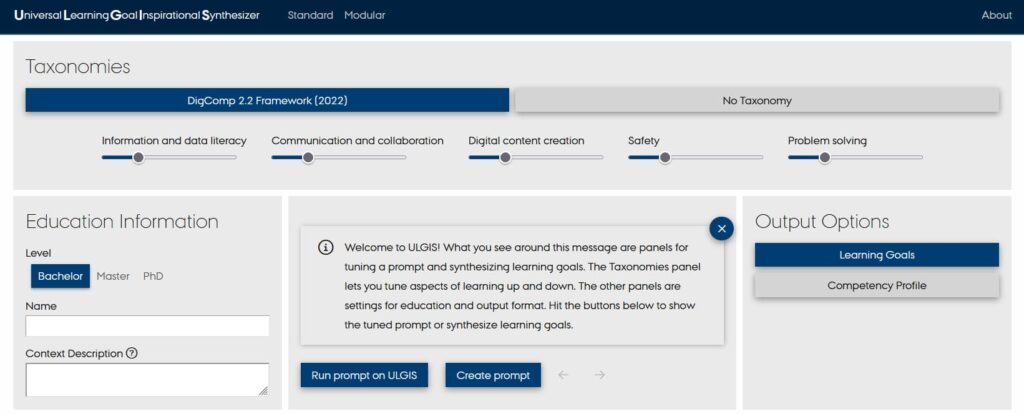The Universal Learning Goal Inspirational Synthesizer (ULGIS) is an innovative digital platform designed to improve educational processes by tailoring learning goals for digital competence development.
This post explores its primary functions, benefits, and how it integrates advanced artificial intelligence (AI) to personalize the learning experience for both educators and students.
Table of Contents
When I first heard about ULGIS, I was intrigued by its promise to assist in digital education.
Primary Function: Tailored Learning Goals
ULGIS is a digital assistant for educators and students that proposes tailored learning goals focused on developing digital competence. Utilizing General Artificial Intelligence (GAI) models, ULGIS analyzes user input and needs to generate refined and personalized learning goals. This ensures educational objectives align with individual requirements and contemporary educational standards.
The Universal Learning Goal Inspirational Synthesizer (ULGIS) is an innovative GAI driven platform designed to integrate and synthesize information from original educational taxonomy definitions. Its primary function is to suggest learning goals for students’ digital competency development on the basis of the EU framework DigComp 2.2. The output is meant to be facilitating learning goal-oriented discussions in different contexts and at various levels.
The ULGIS serves as an inspirational tool for educators and students alike, aiming to optimize the educational development reflections through GAI-driven models. The System was developed by Mads Ronald Dahl (CED, Aarhus University) and programmed by Kasper Fyhn Borg (Aarhus University).
Project Details on https://pure.au.dk/portal/en/projects/universal-learning-goals-inspirational-synthesizer
Standard Mode based on DigComp 2.2.
The standard version features the DigComp 2.2. Taxonomy Framework from 2022.

You can define the educational level between
- Bachelor
- Master
- PhD
and define the context of the learning experience. The tool generates learning goals according to your topic and context description, always based on the respective taxonomy. I did some experiments with AI-assisted creation of learning goals, but this tool is on another level.
In the case of DigComp’s taxonomy, it will generate alongside the following parameters, which can be manually fine-tuned.

- Information and data literacy
- Communication and collaboration
- Digital content creation
- Safety
- Problem-solving
Advanced: Modular Universal Learning Goals Inspirational Synthesizer
The modular version offers various taxonomies and helps tailor the desired output. To me, this is one of the critical benefits of ULGIS. It integrates seamlessly with a couple of existing curriculum frameworks, perfectly complements traditional curriculum creation, and adds a welcome layer to adjust more dynamically to student’s needs.

- Bloom’s Taxonomy
- SOLO Taxonomy
- Harrow’s Taxonomy for the Psychomotor Domain
- Krathwohl’s Affective Domain Theory
Conclusion
I look forward to fine-tuning the outcomes according to the mix of critical parameters available. I encourage fellow educators and institutions to explore ULGIS and integrate it into their curricula. Staying ahead in digital education is not just about keeping up with trends; it’s about ensuring that our students are equipped with the skills they need to succeed in the future.
